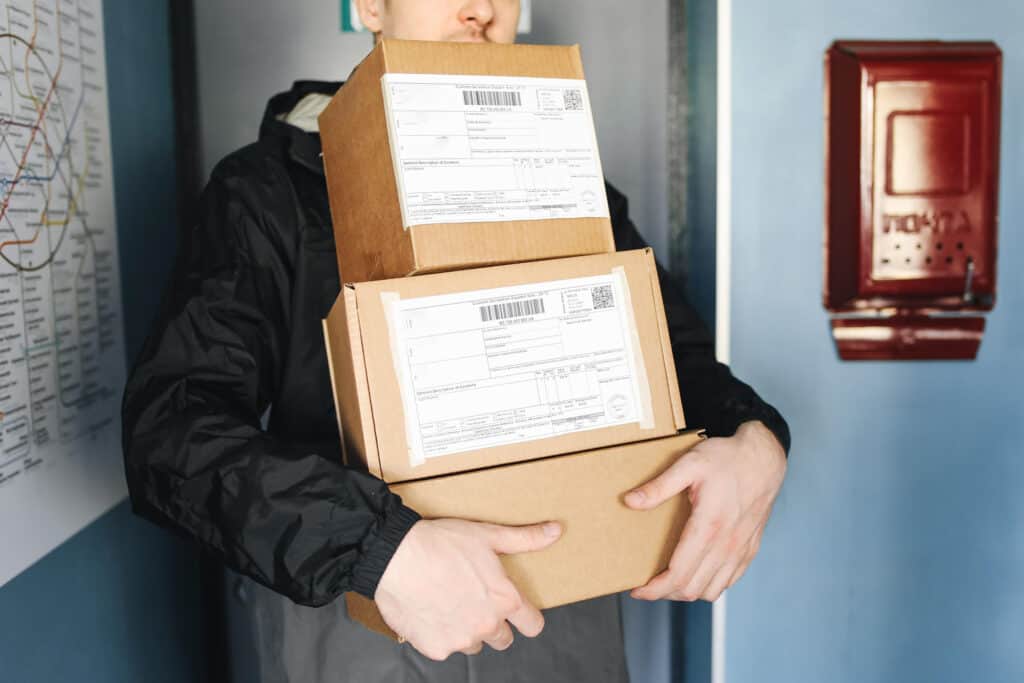Exploring the Delivery Journey: Last-Mile vs. First-Mile Delivery

Wise Systems

There’s an increasingly prominent focus on logistics strategy in today’s dynamic eCommerce landscape. This is no surprise, considering how delivery efficiency impacts customer satisfaction, company reputation, and the bottom line.
The ‘first mile’ and ‘last mile’ are two integral components of this conversation. Both play crucial roles in the delivery process but hold their unique challenges and opportunities. Understanding these differences is vital for logistics managers, supply chain managers, and retailers.
In this article:
- What is First-Mile Delivery?
- What is Last-Mile Delivery?
- Link Between the First and Last Mile
- Frequently Asked Questions
What is First Mile Delivery?

First-mile delivery is a term coined by the logistics industry to refer to the beginning of the supply chain process. This initial stage is initiated when an order is placed, and goods are collected from the manufacturer or supplier. It encompasses everything from quality checks, packaging, paperwork, and the transportation of these goods to a warehouse, distribution center, or cargo ship in case of international shipping.
This part of the logistics chain is critical because it sets the pace for the entire journey. Any delay, error, or miscommunication during the first mile could disrupt the rest of the chain. Moreover, the first mile is a complex operation involving multiple stakeholders – from suppliers and freight forwarders to custom agents and warehouse managers. It requires careful planning, reliable coordination, and robust technological support to ensure smooth and timely execution.
First Mile Operations
The journey starts with the pickup of goods from the supplier or manufacturer. At this point, the products are typically packaged in bulk, ensuring their safety during transit. A comprehensive label, including all relevant details like product description, quantity, destination, and tracking information, is affixed for seamless identification and tracking.
Post packaging, these goods are loaded onto delivery trucks or other transportation modes. An efficient route is planned to transport these goods to a warehouse or distribution center. Simultaneously, the necessary documentation is prepared for a smooth transit process. For cross-border deliveries, this includes customs declarations and any other paperwork required for regulatory compliance.
Upon reaching the warehouse or distribution center, the goods are checked-in, their arrival is recorded, and they are stored appropriately. The completion of these steps signifies the end of the first-mile delivery process, and the orders are now ready to be picked for final mile delivery to customers.
Challenges in First-Mile Delivery
The first-mile delivery process involves an intricate web of activities that can present a range of unique challenges. A more granular look at these difficulties helps to identify key areas for strategic planning and improvement:
- Supplier Reliability: Dependence on multiple suppliers with varying levels of reliability can result in unpredictability. This variability affects production planning, inventory management, and overall efficiency.
- Coordination: Synchronizing schedules with suppliers, freight forwarders, and warehouse teams is an intricate task. A few minutes delay in pickup can create a domino effect, causing subsequent delays across the supply chain.
- Inventory Management: Accurately forecasting demand and managing inventory are fundamental to preventing stockouts or overstock situations. Both scenarios can be costly and detrimental to the flow of goods.
- Regulatory Compliance: Adhering to a host of regulations, ranging from safety standards to environmental compliance, is necessary but often challenging. In cross-border transactions, these regulations multiply.
- Documentation: Meticulous documentation is required for every step of the first mile journey. From purchase orders and invoices to packing lists and bills of lading, every document must be precise to avoid issues during transport or customs clearance.
- Product Quality Assurance: The first mile is the final opportunity to ensure that the quality of products matches the specifications. Any discrepancies can lead to costly returns, replacements, or dissatisfied customers down the line.
- Packaging: Ensuring appropriate packing is an often overlooked aspect of first-mile delivery. The packaging needs to adequately protect the product during transit, be cost-effective, and align with the company’s sustainability goals. Packaging might also need to comply with certain standards or regulations, especially for delicate or hazardous materials. Packaging may or may not occur again before the final mile process, so careful thought and consideration are important here.
Strategies for First-Mile Delivery
To maximize the efficiency of the first mile, a combination of advanced technology and strategic partnerships is needed. Here’s how businesses can refine their first mile strategies:
- Advanced Supply Chain Management Systems: These systems, often driven by AI and Machine Learning, provide real-time tracking and coordination tools. For instance, integrated GPS tracking allows logistics managers to monitor the movement of goods in real-time. The analytical capabilities of these systems also enable data-driven decision-making, such as optimal scheduling of pickups and drop-offs.
- Supplier Relationship Management: Regular communication, feedback mechanisms, and digital platforms for information are key to nurturing strong, robust relationships with suppliers.
- Quality Checks: Regular quality assessments at the supplier’s end help prevent discrepancies at the source, reducing returns or replacements further along the supply chain.
- Strategic Partnerships: Partnering with local logistics providers can increase flexibility, enabling businesses to adapt to unexpected changes or demand surges without hesitation.
What is Last-Mile Delivery?

Last-mile delivery, on the other hand, signifies the final stretch of a product’s journey from the distribution center to the end recipient’s doorstep. This phase is considered the most important yet challenging part of the supply chain due to its direct interaction with the customer.
The term last mile can be misleading as it doesn’t refer to a literal mile. It could range from a few blocks to more than 50 miles, depending upon the location of the customer. The main objective here is to ensure the order reaches the customer quickly, accurately, and in perfect condition.
Last Mile Operations
The last-mile phase involves a variety of activities, starting with picking the correct orders from the warehouse inventory and preparing them for delivery. The products may remain in their original packaging as received from the supplier, or they might be repackaged – either for brand consistency or when an order contains multiple items. Any repackaged orders require new labels to ensure accurate tracking.
Once the orders are prepped, they’re loaded onto delivery vehicles, and the delivery route is planned. At this point, customers are informed that their order is en route. This notification often includes a tracking number so customers can easily follow their package’s movement. Finally, orders are delivered to the customers, marking the completion of the last-mile delivery process.
Challenges in Last-Mile Delivery
Within the industry, the last mile is notoriously complex and costly, accounting for a whopping 53% of the total delivery cost per some estimates. It involves numerous touchpoints, from sorting at the warehouse to transportation to individual home addresses.
- Traffic Congestion: The delivery route might involve navigation through busy roads and traffic congestion, leading to delays in delivery and increased fuel consumption.
- Address Errors: Wrong or unclear addresses are common in last-mile delivery. Such errors lead to failed delivery attempts, additional re-delivery attempts, and customer dissatisfaction.
- Failed Delivery Attempts: A delivery attempt could fail for numerous reasons, such as customer unavailability, restricted access to the delivery location, or proof of signature requirements. These failed attempts multiply the delivery costs and negatively impact customers.
- Rapid Delivery Expectations: In today’s fast-paced eCommerce landscape, customers expect a quick turnaround from the time of ordering to delivery, often on the same or next day. Meeting these expectations while managing cost and efficiency is a significant challenge.
- Route Optimization: Determining the most efficient delivery routes is a key concern. Changing traffic patterns, the sequence of package delivery, and the location of customers must be taken into account. Route optimization reduces delivery times, saves fuel, and increases the number of deliveries per trip.
- Rural Deliveries: Delivery to rural or remote areas presents its own set of issues due to longer distances, lack of proper addresses, difficult terrain, and lower parcel density.
- Fleet Management: Effective management of the delivery fleet involves maintaining the vehicles, managing driver schedules, and ensuring vehicles are loaded optimally.
Link Between the First and Last Mile
While distinct in their operations, the first and last mile are closely interconnected. Disruptions or inefficiencies in the first mile can have a cascading effect on the entire supply chain, including the last mile. Similarly, customer feedback from the last mile can identify potential improvements for the first mile. Therefore, a holistic approach to managing both aspects is at the core of maintaining a smooth supply chain.
Here, solutions like the Wise Systems delivery automation platform powered by an AI-driven Dynamic Optimization Engine (DOE) can be instrumental in managing the final mile. Wise Systems platform analyzes operational data to help your business make more intelligent decisions with real-time recommendations from route optimizations to delivery tracking.
Wise Systems equips businesses with a comprehensive suite of tools designed to refine and optimize last mile operations. Offering solutions that cater to your specific challenges and needs, Wise Systems is committed to helping your business excel. Don’t wait. Request a demo today to start your journey towards superior last mile delivery.
Frequently Asked Questions
What is the difference between the first mile, middle mile, and last miles?
- First Mile: The first mile refers to the initial leg of the supply chain where goods are transported from the point of origin, such as a manufacturer or supplier, to the nearest distribution center or transportation hub.
- Middle Mile: The middle mile involves the transportation of goods from the distribution centers or hubs to regional centers or local facilities closer to the end consumers.
- Last Mile: The last mile represents the final stage of the delivery process, where goods are transported from the local facilities to the end consumers’ doorsteps or designated delivery locations.
What is considered last-mile delivery?
Last mile delivery is the transportation and delivery of goods from the final point in the supply chain, often a local distribution center or retail store, to the end consumer’s doorstep or preferred delivery location. It is the crucial last step in the logistics chain, ensuring that products reach their intended recipients.
What is the disadvantage of last-mile delivery?
The disadvantages associated with last-mile delivery include:
- High Costs: Last-mile delivery tends to be the most expensive part of the supply chain due to the complexity of delivering individual packages to various locations and the need for multiple vehicles and drivers.
- Traffic and Congestion: Urban areas, where last-mile deliveries are frequent, are often congested with traffic, leading to delays and difficulties in making timely deliveries.
- Environmental Impact: Last-mile delivery contributes to increased carbon emissions and pollution, especially when using traditional fuel-powered delivery vehicles, impacting air quality and the environment.
- Delivery Challenges: Delivering to remote or difficult-to-reach locations can be challenging, increasing delivery times and costs.
- Last-Minute Changes: Customer demands for flexible delivery options and last-minute changes in delivery schedules can pose operational challenges for companies.
To address these disadvantages, companies are exploring innovative solutions like using electric vehicles, optimizing delivery routes with solutions such as the Wise Systems delivery automation platform, deploying smart lockers, and exploring alternative delivery methods, such as drones and autonomous vehicles.

